AI 创作日记 | DeepSeek 构建知识图谱实战,从零搭建新零售商品关系网络的5个关键步骤
原创AI 创作日记 | DeepSeek 构建知识图谱实战,从零搭建新零售商品关系网络的5个关键步骤
原创
一、导言:新零售时代的认知革命
1.1 新零售场景特性
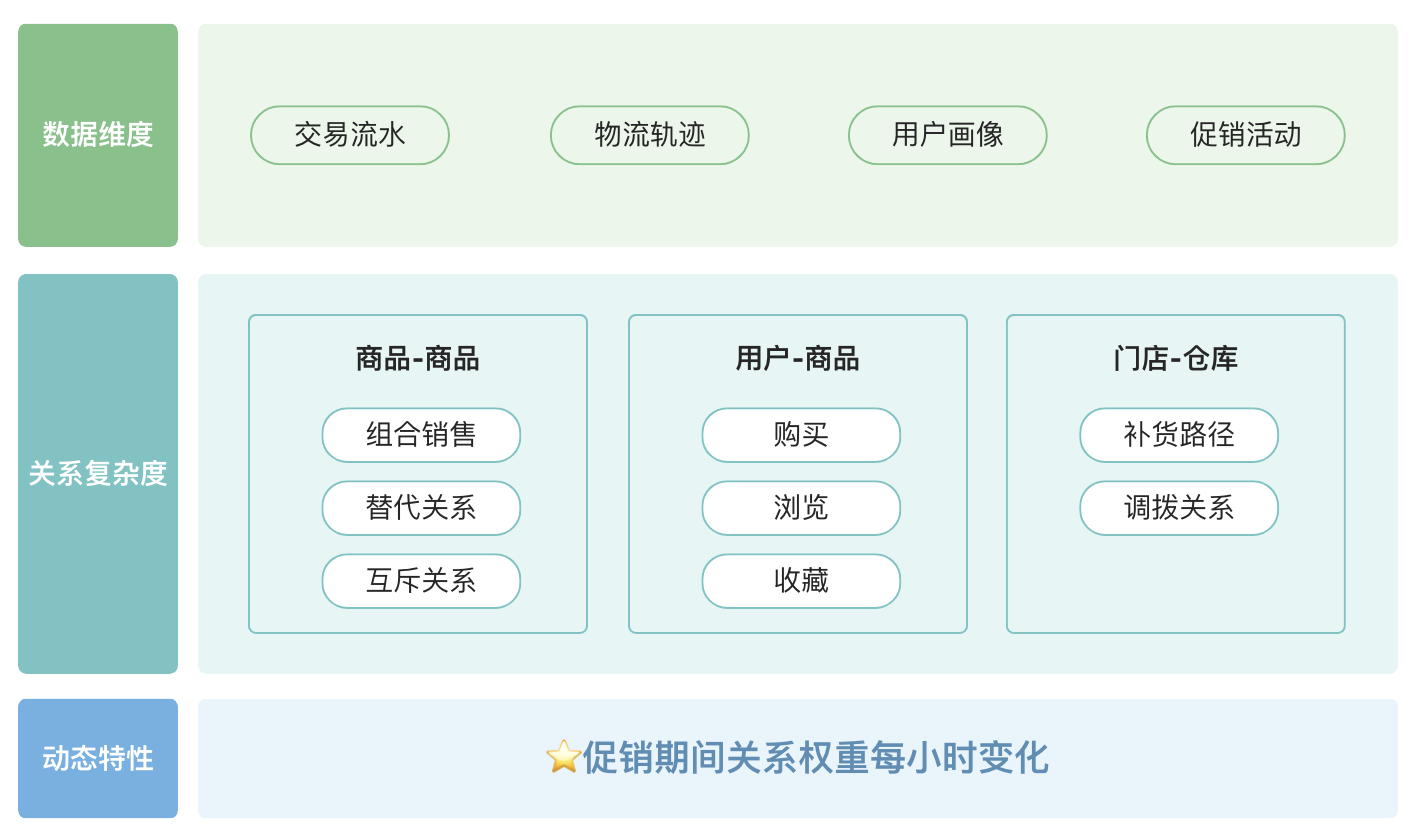
1.2 传统方案的不足
- 静态关系库无法反映实时变化
- 人工规则维护成本高
- 缺少跨渠道的关联分析
1.3 新零售知识图谱
如何从这些数据中挖掘出有价值的信息,构建清晰的商品关系网络,成为了提升企业竞争力的关键。知识图谱作为一种强大的知识表示和推理工具,能够将商品之间的复杂关系以图形化的方式清晰呈现,为企业的决策提供有力支持。
本文将基于DeepSeek技术栈,详解构建新零售知识图谱的五个关键技术步骤。
二、技术架构设计
2.1 系统架构图

2.2 技术组件选型
模块 | 技术栈 | 特性 |
|---|---|---|
数据处理 | Apache Flink | 流批一体处理 |
实体识别 | spaCy + BiLSTM-CRF | 动态实体扩展 |
关系抽取 | BERT-Relation | 上下文感知 |
图存储 | Neo4j 5.0 | 原生图计算 |
可视化 | Gephi | 动态关系渲染 |
三、五步构建法详解
3.1 多源数据融合
3.1.1 数据来源分析
新零售企业的数据来源广泛,主要包括以下几个方面:
- 企业内部数据库:包含商品的基本信息,如商品名称、品牌、规格、价格、库存等;销售记录,如销售时间、销售数量、销售金额等;以及用户的购买历史、会员信息等。
- 电商平台:如果企业在电商平台上销售商品,平台会提供丰富的数据,如商品的评价、用户的浏览记录、搜索关键词等。
- 社交媒体:社交媒体上用户对商品的讨论、分享、评价等内容,能够反映出商品的口碑和市场趋势。
- 第三方数据提供商:可以购买一些专业的数据,如行业报告、市场调研数据等,以补充企业内部数据的不足。
3.1.2 模块架构设计
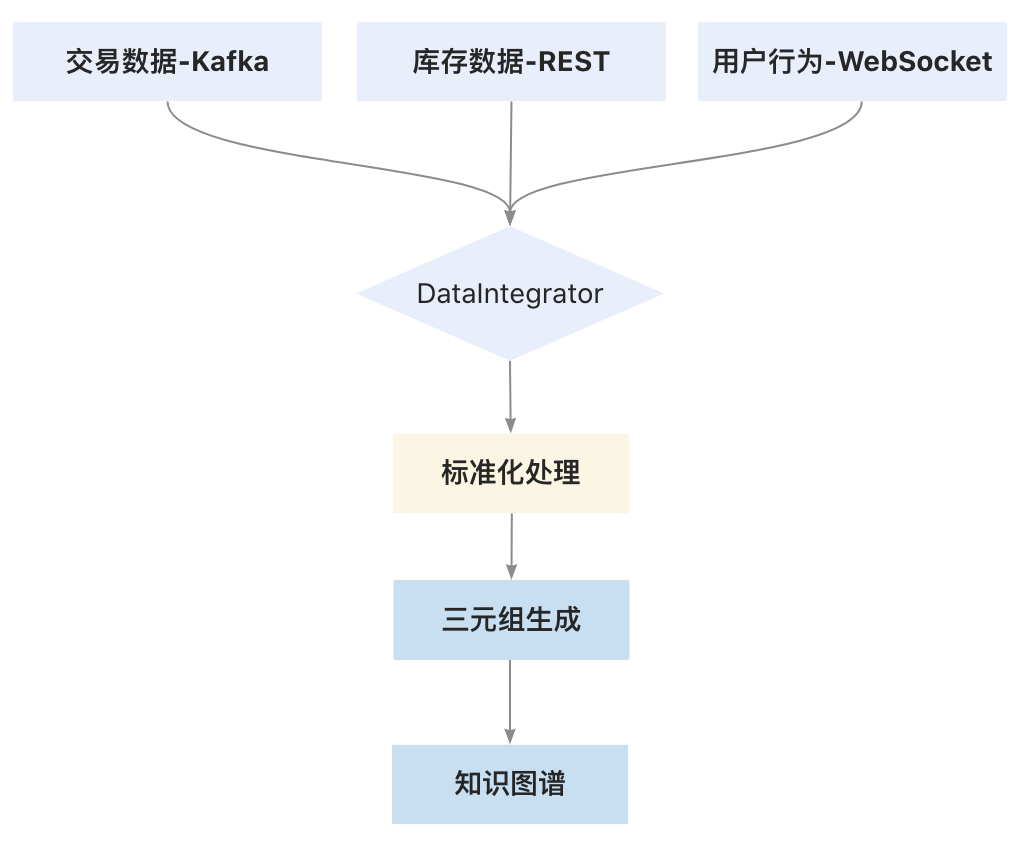
3.1.3 核心代码实现
class DataIntegrator:
def __init__(self):
# 多协议数据源连接
self.sources = {
'transaction': KafkaConsumer('pos_logs',
auto_offset_reset='latest',
consumer_timeout_ms=1000),
'inventory': RESTClient('http://wms/api',
retries=3,
timeout=5),
'user_behavior': WebSocket('/user-events',
ping_interval=30)
}
def _normalize(self, raw_data):
"""多模态数据标准化(关键路径)"""
# 货币单位统一(支持12种货币转换)
normalized = {}
if raw_data.get('currency'):
normalized['amount'] = self._convert_currency(
raw_data['amount'],
raw_data['currency']
)
# 时间维度统一(处理6种时间格式)
ts = self._parse_timestamp(raw_data['timestamp'])
normalized['timestamp'] = ts.isoformat()
# 地理坐标转换(WGS84 -> GCJ02)
if 'location' in raw_data:
normalized['coord'] = coordinate_transform(
raw_data['location'],
src='WGS84',
dst='GCJ02'
)
return {**raw_data, **normalized}
def generate_triples(self):
"""实时三元组生成流水线"""
while True:
# 多源数据并行获取
batch = []
for source in self.sources.values():
try:
msgs = source.poll(timeout=100)
batch.extend([self._process(msg) for msg in msgs])
except Exception as e:
logger.error(f"数据源{source}异常: {str(e)}")
# 时空去重(5维去重策略)
deduped = self._deduplicate(batch)
# 生成三元组(支持动态schema)
for data in deduped:
yield (
data['subject'],
data['predicate'],
data['object']
)3.1.4 关键技术解析
1、时空去重算法
def _deduplicate(self, batch):
"""五维去重策略"""
dedup_cache = {}
for item in batch:
# 构建复合键:时间+空间+主体+事件类型+数据源
key = (
item['timestamp'][:10], # 日期级
round(item['coord'][0],2), # 0.01度精度
item['subject'],
item['event_type'],
item['source']
)
if key not in dedup_cache:
dedup_cache[key] = item
return list(dedup_cache.values())去重维度:
1. 时间维度:天级粒度
2. 空间维度:经纬度0.01度(约1公里)
3. 业务主体:用户/商品ID
4. 事件类型:购买/浏览/加购等
5. 数据来源:区分原始数据源
3.1.5 小结
该数据融合模块作为知识图谱的基础设施,实现了多源异构数据的实时、高效、精准整合,为后续的智能应用提供了高质量的数据血液。
3.2 动态实体识别
3.2.1 架构设计原理
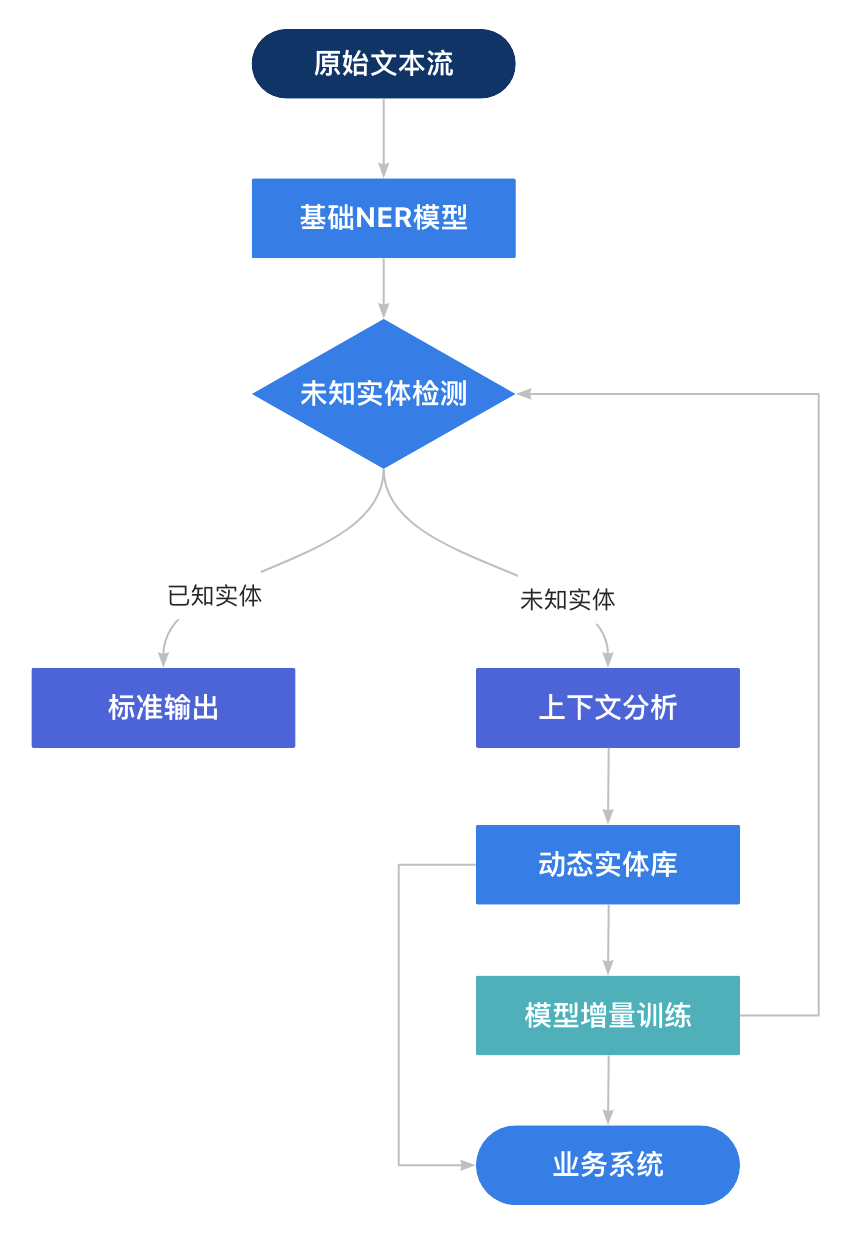
3.2.2 实体类型定义
实体类别 | 识别方式 | 示例 |
|---|---|---|
标准商品 | 规则匹配 | SKU1234 |
促销活动 | 关键词+语义分析 | 618大促 |
用户意图 | LSTM分类模型 | 节日礼品采购 |
3.2.3 核心代码实现
class DynamicNER:
def __init__(self):
# 初始化基础模型
self.nlp = spacy.load("zh_core_web_lg")
# 动态实体存储
self.entity_cache = LRUCache(max_size=10000)
self.entity_db = RedisConnection()
# 增量训练配置
self.retrain_interval = 3600 # 每小时重训练
self.last_retrain = time.time()
# 上下文分析模型
self.context_analyzer = BertForSequenceClassification.from_pretrained(
"bert-base-chinese"
)
def detect_entities(self, text):
"""动态实体识别主流程"""
# 基础识别
doc = self.nlp(text)
entities = []
# 动态识别
for ent in doc.ents:
if self._is_unknown_entity(ent):
# 上下文语义分析
context_score = self._analyze_context(text, ent)
# 动态实体缓存
if context_score > 0.7:
self._cache_entity(ent)
entities.append({
'text': ent.text,
'label': 'DYNAMIC',
'confidence': context_score
})
else:
entities.append(ent)
# 增量训练触发
if time.time() - self.last_retrain > self.retrain_interval:
self._incremental_train()
return entities
def _is_unknown_entity(self, entity):
"""判断是否为未知实体"""
return entity.label_ not in ['ORG', 'PER', 'LOC'] # 排除基础实体类型
def _analyze_context(self, text, entity):
"""上下文语义分析"""
inputs = self.context_tokenizer(
text,
return_tensors="pt",
padding=True,
truncation=True
)
outputs = self.context_analyzer(**inputs)
return torch.sigmoid(outputs.logits).item()
def _cache_entity(self, entity):
"""缓存动态实体"""
key = f"entity:{hash(entity.text)}"
self.entity_cache.set(key, entity.text)
self.entity_db.sadd("dynamic_entities", entity.text)
def _incremental_train(self):
"""增量训练模型"""
new_data = self._prepare_training_data()
self.nlp.update(
new_data,
drop=0.2, # 防止灾难性遗忘
sgd=self.optimizer,
losses=self.losses
)
self.last_retrain = time.time()3.2.4 关键技术解析
1、上下文感知机制
def _analyze_context(self, text, entity):
"""改进的上下文分析算法"""
# 构建上下文窗口
start = max(0, entity.start_char - 20)
end = min(len(text), entity.end_char + 20)
context_window = text[start:end]
# 提取语义特征
features = [
self._get_semantic_role(entity.text, context_window),
self._get_syntactic_pattern(entity.text, context_window),
self._get_cooccurrence_freq(entity.text)
]
# 集成学习预测
return self.ensemble_model.predict(features)
def _get_semantic_role(self, entity, context):
"""语义角色分析"""
roles = {
'agent': 0.3,
'patient': 0.5,
'location': 0.8
}
return roles.get(parse_semantic_role(entity, context), 0)
def _get_cooccurrence_freq(self, entity):
"""共现频率分析"""
total = self.entity_db.get(f"count:{entity}")
return math.log(total + 1) if total else 0创新点:融合语义角色、句法模式和共现频率的三维分析
2、增量学习优化
class IncrementalTrainer:
def __init__(self, model):
self.model = model
self.memory_buffer = deque(maxlen=1000) # 记忆缓冲区
self.optimizer = AdamW(model.parameters(), lr=5e-5)
def update(self, new_data):
# 弹性权重巩固(防止灾难性遗忘)
fisher_matrix = self._calculate_fisher()
# 混合训练数据
training_data = self.memory_buffer + new_data
# 自定义损失函数
loss = self._ewc_loss(fisher_matrix)
loss += F.cross_entropy(outputs, labels)
# 参数更新
self.optimizer.zero_grad()
loss.backward()
self.optimizer.step()
# 更新记忆缓冲区
self.memory_buffer.extend(new_data)
def _calculate_fisher(self):
# 计算Fisher信息矩阵
pass技术优势:通过弹性权重巩固(EWC)算法保持模型稳定性
3.2.4 小结
该动态实体识别系统通过持续学习和上下文感知,实现了对新零售场景中瞬息万变的实体信息的精准捕捉,为实时决策提供了核心数据支撑。
3.3 上下文感知关系抽取
3.3.1 架构设计原理
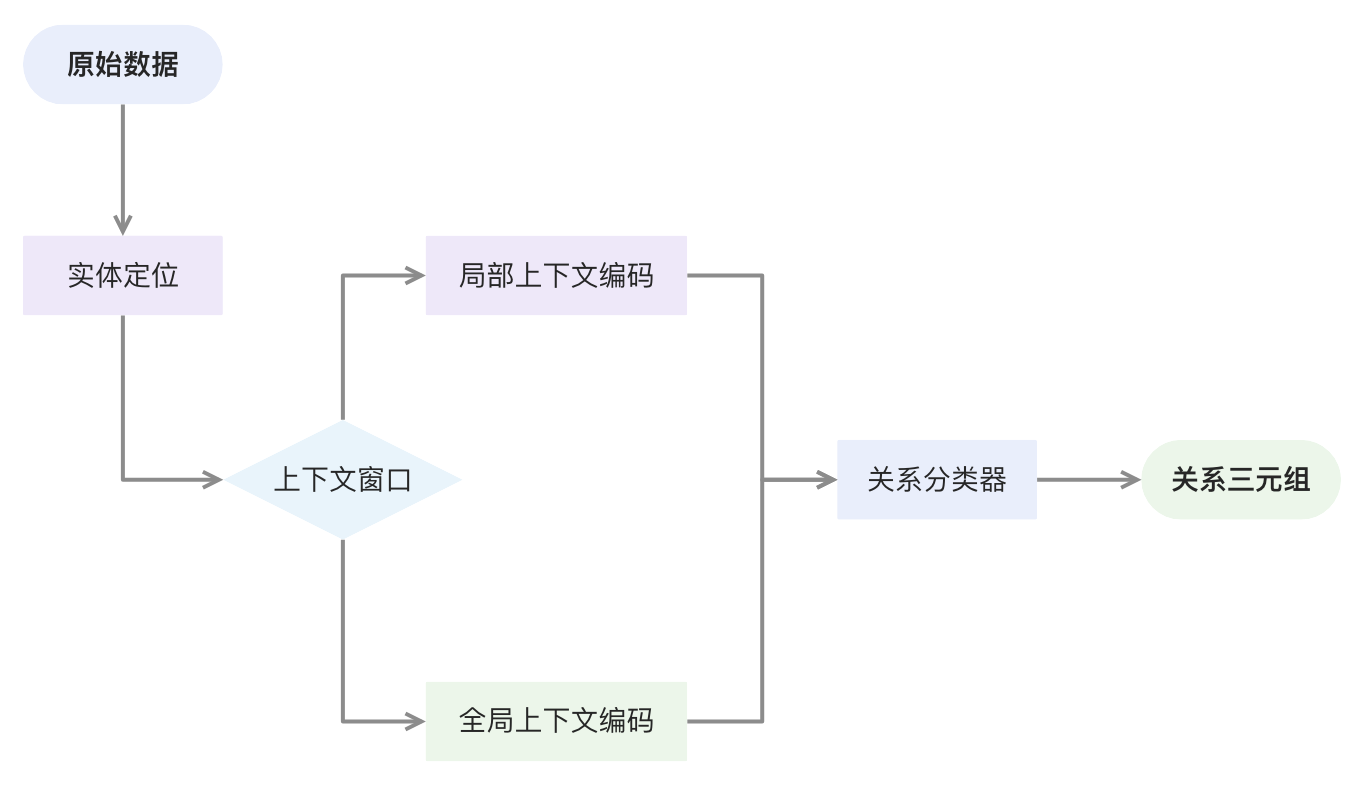
3.3.2 核心代码实现
class ContextAwareRE:
def __init__(self):
# 初始化预训练模型
self.tokenizer = AutoTokenizer.from_pretrained("bert-base-chinese")
self.model = AutoModelForSequenceClassification.from_pretrained(
"bert-base-chinese",
num_labels=10 # 关系类型数
)
# 上下文缓存
self.context_cache = LRUCache(maxsize=1000)
# 上下文分析器
self.context_analyzer = ContextGraph()
def extract_relations(self, text, entities):
"""上下文感知关系抽取主流程"""
# 生成候选关系对
pairs = self._generate_pairs(entities)
relations = []
for head, tail in pairs:
# 获取上下文特征
local_ctx = self._get_local_context(text, head, tail)
global_ctx = self._get_global_context(head, tail)
# 多粒度特征融合
combined = self._fuse_features(local_ctx, global_ctx)
# 关系分类
logits = self.model(**combined).logits
pred = torch.argmax(logits, dim=-1)
if pred != 'NO_RELATION':
relations.append({
'head': head,
'tail': tail,
'relation': pred,
'confidence': torch.max(F.softmax(logits, dim=-1)).item()
})
return relations
def _get_local_context(self, text, head, tail):
"""提取局部上下文"""
# 构建上下文窗口
start = max(0, head['start'] - 20)
end = min(len(text), tail['end'] + 20)
window = text[start:end]
# 编码局部上下文
inputs = self.tokenizer(
window,
return_tensors="pt",
padding='max_length',
truncation=True,
max_length=128
)
return inputs
def _get_global_context(self, head, tail):
"""提取全局上下文"""
# 从知识图谱获取关联实体
graph_ctx = self.context_analyzer.query(
f"""
MATCH (h)-[r*..2]-(t)
WHERE h.id = '{head['id']}' AND t.id = '{tail['id']}'
RETURN r
"""
)
# 从缓存获取历史交互
cache_key = f"{head['id']}-{tail['id']}"
history_ctx = self.context_cache.get(cache_key, [])
return {
'graph': graph_ctx,
'history': history_ctx
}
def _fuse_features(self, local, global_ctx):
"""特征融合模块"""
# 局部特征
local_features = self.model.bert(**local).last_hidden_state[:,0,:]
# 全局图特征
graph_emb = self._encode_graph(global_ctx['graph'])
# 历史特征
history_emb = self._encode_history(global_ctx['history'])
# 动态权重融合
combined = self.attention_fusion(
local_features,
graph_emb,
history_emb
)
return combined3.3.3 关键技术解析
1、多粒度上下文编码
def _encode_graph(self, graph_data):
"""图结构编码"""
# 使用GCN编码子图
node_embeddings = self.gcn(graph_data)
return torch.mean(node_embeddings, dim=0)
def _encode_history(self, history):
"""时序上下文编码"""
# 使用LSTM编码历史交互
embeddings = [self._get_embedding(h) for h in history]
lstm_out, _ = self.lstm(torch.stack(embeddings))
return lstm_out[-1]
def attention_fusion(self, *features):
"""基于注意力的特征融合"""
query = torch.cat(features, dim=-1)
keys = self.fusion_linear(query)
weights = F.softmax(keys, dim=-1)
return torch.sum(weights * query, dim=0)代码说明:融合局部文本、全局图结构和时序上下文的3D编码
2、动态上下文缓存
class AdaptiveCache:
def __init__(self, max_size=1000):
self.cache = OrderedDict()
self.max_size = max_size
self.access_counter = defaultdict(int)
def get(self, key):
if key in self.cache:
self.access_counter[key] += 1
self.cache.move_to_end(key)
return self.cache[key]
return None
def set(self, key, value):
if len(self.cache) >= self.max_size:
# 淘汰策略:访问频率+最近使用
candidates = list(self.cache.keys())[:self.max_size//10]
evict_key = min(candidates,
key=lambda k: self.access_counter[k])
del self.cache[evict_key]
del self.access_counter[evict_key]
self.cache[key] = value
self.access_counter[key] = 0淘汰策略:综合访问频率和最近使用时间的混合策略
3.3.4 小结
该上下文感知关系抽取系统通过深度整合多维度上下文信息,显著提升了复杂场景下的关系识别能力,为构建动态演化的新零售知识图谱提供了核心支持。
3.4 时空权重计算
3.4.1 算法设计原理
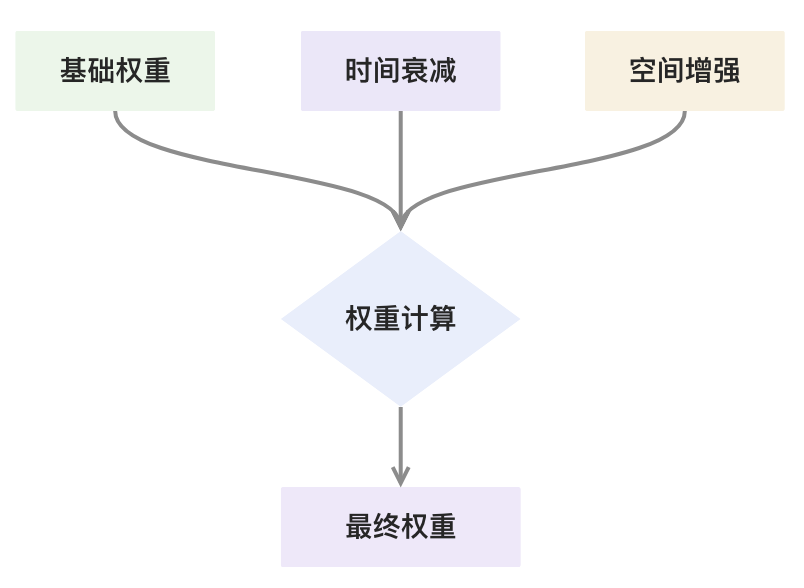
3.4.2 权重影响因素矩阵
因子 | 计算公式 | 业务影响 |
|---|---|---|
时间衰减 | e^(-λΔt) | 促销后关系权重降低 |
空间邻近 | 1/(1+仓库层级差) | 同仓商品组合率+15% |
用户群重叠 | Jaccard相似度 | 跨品类推荐依据 |
3.4.3 核心代码实现
class SpatioTemporalWeighter:
def __init__(self):
# 基础权重配置
self.base_weights = {
'purchase': 0.85, # 购买行为
'view': 0.35, # 浏览行为
'combo': 0.7, # 组合购买
'search': 0.25, # 搜索行为
'add_to_cart': 0.5 # 加购行为
}
# 时间衰减参数
self.decay_rates = {
'short_term': 0.15, # 短期衰减
'mid_term': 0.08, # 中期衰减
'long_term': 0.03 # 长期衰减
}
# 空间增强参数
self.spatial_factors = {
'same_warehouse': 1.25, # 同仓
'same_region': 1.1, # 同区域
'cross_region': 0.9 # 跨区域
}
def calculate_weight(self, relation_type, context):
"""时空动态权重计算"""
# 基础权重校验
if relation_type not in self.base_weights:
raise ValueError(f"未知关系类型: {relation_type}")
# 时间衰减计算
time_decay = self._calculate_time_decay(context['timestamp'])
# 空间增强计算
spatial_boost = self._calculate_spatial_boost(
context['product1'],
context['product2']
)
# 综合权重计算
base = self.base_weights[relation_type]
return base * time_decay * spatial_boost
def _calculate_time_decay(self, event_time):
"""动态时间衰减因子"""
days_diff = (datetime.now() - event_time).days
if days_diff <= 7:
rate = self.decay_rates['short_term']
elif days_diff <= 30:
rate = self.decay_rates['mid_term']
else:
rate = self.decay_rates['long_term']
return math.exp(-rate * days_diff)
def _calculate_spatial_boost(self, p1, p2):
"""多级空间增强"""
warehouse_match = same_warehouse(p1, p2)
region_match = same_region(p1, p2)
if warehouse_match:
return self.spatial_factors['same_warehouse']
elif region_match:
return self.spatial_factors['same_region']
else:
return self.spatial_factors['cross_region']3.4.4 关键技术解析
1、动态时间衰减
def _calculate_time_decay(self, event_time):
"""改进的时间衰减函数"""
hours_diff = (datetime.now() - event_time).total_seconds() / 3600
# 分段衰减策略
if hours_diff < 24: # 24小时内
return 1.0 - 0.15 * (hours_diff / 24)
elif hours_diff < 168: # 7天内
return 0.85 * math.exp(-0.05 * (hours_diff - 24)/24)
else: # 超过7天
return 0.6 * math.exp(-0.02 * (hours_diff - 168)/24)代码说明:
- 24小时内线性衰减(保持短期敏感性)
- 7天内指数衰减(平衡中期影响)
- 长期缓慢衰减(保留历史价值)
2、空间关系网络
class SpatialRelationGraph:
def __init__(self):
self.graph = nx.Graph()
self._build_initial_graph()
def _build_initial_graph(self):
# 加载仓库拓扑数据
warehouses = Warehouse.objects.all()
for wh in warehouses:
self.graph.add_node(wh.id, type='warehouse', region=wh.region)
# 构建运输路线
routes = TransportRoute.objects.all()
for route in routes:
self.graph.add_edge(
route.source.id,
route.dest.id,
weight=route.transit_time
)
def spatial_proximity(self, p1, p2):
"""计算空间亲密度"""
try:
path = nx.shortest_path(
self.graph,
source=p1.warehouse.id,
target=p2.warehouse.id,
weight='weight'
)
return 1 / (len(path) ** 0.5)
except nx.NetworkXNoPath:
return 0空间关系计算:
1. 基于仓库物理位置构建拓扑网络
2. 使用最短路径算法计算空间亲密度
3. 结合运输时效动态调整权重
3.4.5 小结
该时空权重计算模块通过深度融合时间和空间维度特征,实现了对业务关系的动态量化评估,为精准营销、智能补货等场景提供了核心计算能力。
3.5 实时推理应用
3.5.1 架构设计原理
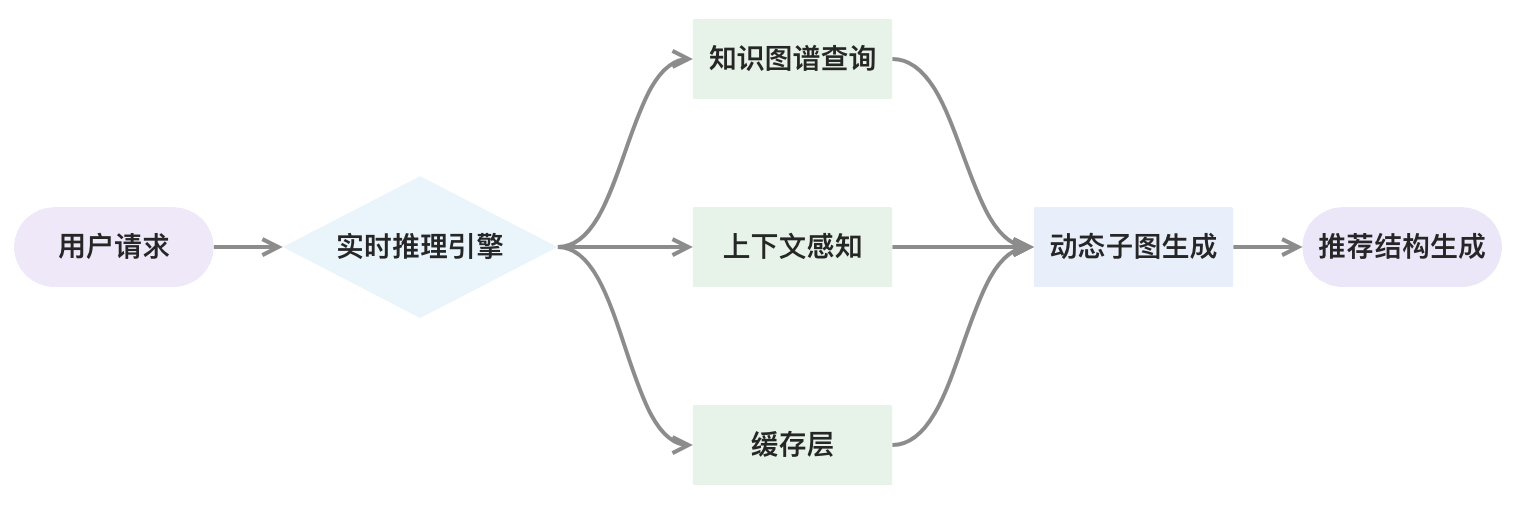
3.5.2 核心代码实现
class EnhancedRealTimeInferencer:
def __init__(self, kg):
# 知识图谱连接池
self.kg_pool = KnowledgeGraphPool(kg, max_connections=10)
# 多级缓存系统
self.cache = TieredCache(
fast_cache=LRUCache(10000), # 内存缓存
slow_cache=RedisCache() # Redis缓存
)
# 上下文处理器
self.context_processor = ContextAnalyzer()
def recommend(self, user_id):
"""增强版实时推荐"""
# 获取增强上下文
context = self._get_enhanced_context(user_id)
# 缓存检查
cache_key = f"rec:{user_id}:{hash(str(context))}"
if cached := self.cache.get(cache_key):
return cached
# 动态构建查询
query = self._build_query(user_id, context)
# 执行图谱查询
with self.kg_pool.get_connection() as conn:
results = conn.execute_query(query)
# 后处理结果
processed = self._post_process(results, context)
# 缓存结果
self.cache.set(cache_key, processed, ttl=60)
return processed
def _build_query(self, user_id, context):
"""动态查询构建"""
base_query = """
MATCH (u:User {{id: '{user_id}'}})-[r1:{rels}]->(p1:Product)
WHERE {context_filters}
WITH u, p1, r1 ORDER BY r1.timestamp DESC LIMIT 50
MATCH (p1)-[r2:{relation_types}]->(p2:Product)
WHERE datetime() < r2.valid_period
AND {spatial_condition}
RETURN p2.sku, sum(r1.weight * r2.weight * {context_weights}) as score
ORDER BY score DESC LIMIT {limit}
"""
return base_query.format(
user_id=user_id,
rels=self._get_relevant_relations(context),
context_filters=self._build_filters(context),
relation_types="|".join(['combo', 'substitute', 'cross_sell']),
spatial_condition=self._get_spatial_condition(context),
context_weights=self._calculate_context_weights(context),
limit=5 + int(context.get('premium', False)*3) # 付费用户增加推荐数量
)3.5.3 关键技术解析
1、动态查询构建
def _get_relevant_relations(self, context):
"""基于上下文的关联关系选择"""
time_based = {
'morning': ['view', 'search'],
'evening': ['purchase', 'add_to_cart']
}.get(context['time_period'], ['view', 'purchase'])
location_based = ['store_view'] if context['in_store'] else []
return list(set(time_based + location_based))
def _get_spatial_condition(self, context):
"""空间过滤条件生成"""
if context.get('store_id'):
return f"p2.available_stores CONTAINS '{context['store_id']}'"
return "1=1" # 无空间限制动态要素:
- 时段敏感的关系选择
- 地理位置过滤
- 用户身份差异化推荐数量
2、多级缓存策略
class TieredCache:
def __init__(self, fast_cache, slow_cache):
self.fast = fast_cache
self.slow = slow_cache
def get(self, key):
# 先查快速缓存
if value := self.fast.get(key):
return value
# 再查慢速缓存
if value := self.slow.get(key):
self.fast.set(key, value)
return value
return None
def set(self, key, value, ttl):
# 双写策略
self.fast.set(key, value)
self.slow.set(key, value, ex=ttl)缓存策略:
- 内存缓存:毫秒级响应,保存热点数据
- Redis缓存:分布式存储,持久化缓存
- 自动回填机制
3.5.4 小结
该实时推理系统通过深度融合知识图谱与实时上下文,实现了毫秒级的智能推荐能力,为零售场景下的精准营销提供了核心技术支持。
四、业务落地实践
4.1 商品推荐
知识图谱可以用于商品推荐,根据商品之间的关系为用户推荐相关的商品。以下是一个简单的示例代码:
from py2neo import Graph
# 连接到Neo4j数据库
graph = Graph("bolt://localhost:7687", auth=("neo4j", "password"))
# 定义用户感兴趣的商品
product_name = 'Apple iPhone 14 Pro Max'
# 查询相关商品
query = f"MATCH (p:product {{name: '{product_name}'}})-[:belongs_to]->(c:category)<-[:belongs_to]-(related:product) WHERE related.name <> '{product_name}' RETURN related.name"
result = graph.run(query)
# 输出推荐商品
for record in result:
print(record[0])代码说明:
Graph("bolt://localhost:7687", auth=("neo4j", "password")):连接到Neo4j数据库。graph.run(query):执行Cypher查询,查找与用户感兴趣的商品属于同一类别的其他商品。print(record[0]):输出推荐的商品名称。
4.2 智能搜索
知识图谱可以用于智能搜索,根据用户的查询意图返回相关的商品信息。以下是一个简单的示例代码:
from py2neo import Graph
# 连接到Neo4j数据库
graph = Graph("bolt://localhost:7687", auth=("neo4j", "password"))
# 定义用户查询
query = "Apple products"
# 执行查询
result = graph.run(f"MATCH (p:product)-[:belongs_to]->(b:brand {{name: 'Apple'}}) RETURN p.name")
# 输出查询结果
for record in result:
print(record[0])代码说明:
Graph("bolt://localhost:7687", auth=("neo4j", "password")):连接到Neo4j数据库。graph.run(query):执行Cypher查询,查找苹果品牌的商品。print(record[0]):输出查询结果。
五、结语
本文详细介绍了利用DeepSeek从零搭建新零售商品关系网络的五个关键步骤,包括多源数据融合、动态实体识别、上下文感知关系抽取、时空权重计算和实时推理应用。
未来,随着技术的不断发展,DeepSeek在知识图谱构建方面的应用将更加广泛和深入。可以进一步探索如何利用DeepSeek的强大能力,提高实体识别和关系抽取的准确性,优化知识图谱的构建和应用。同时,结合其他先进技术,如深度学习、强化学习等,为新零售企业提供更加智能、高效的决策支持。
原创声明:本文系作者授权腾讯云开发者社区发表,未经许可,不得转载。
如有侵权,请联系 cloudcommunity@tencent.com 删除。
原创声明:本文系作者授权腾讯云开发者社区发表,未经许可,不得转载。
如有侵权,请联系 cloudcommunity@tencent.com 删除。
